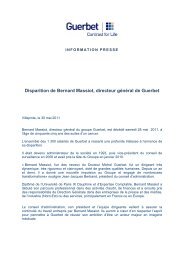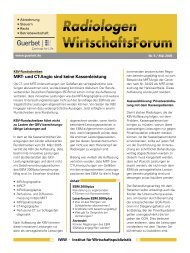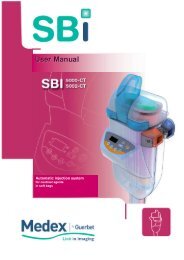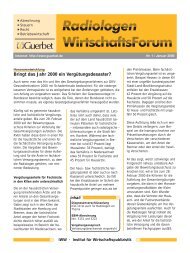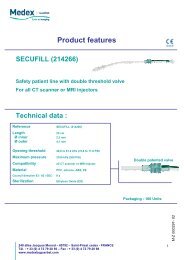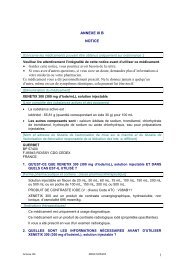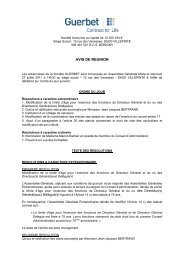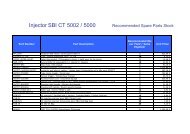Read the Registration Document - Guerbet
Read the Registration Document - Guerbet
Read the Registration Document - Guerbet
Create successful ePaper yourself
Turn your PDF publications into a flip-book with our unique Google optimized e-Paper software.
3.5 <strong>Guerbet</strong> products<strong>Guerbet</strong> growth is based in large part on three major product ranges: Dotarem® (MRI), Xenetix® (X-ray)and Lipiodol®.Dotarem®, a non-specific gadolinium-based MRI contrast agent, has been <strong>Guerbet</strong>’s largest contributor torevenue since 2010 and <strong>the</strong> market leader in volume in Europe. Its physio-chemical properties (it is also <strong>the</strong>only ionic macrocyclic contrast agent available which gives it a particularly high <strong>the</strong>rmodynamic stability)and its optimal security profile makes it <strong>the</strong> industry standard for MRI. Dotarem® is used for <strong>the</strong> explorationof many pathologies and in particular for central nervous system, digestive tract, osteoarticular and vasculardiseases.First launched on <strong>the</strong> market in1989, Dotarem® acquired a leadership position in 2008 when <strong>the</strong>appearance of serious undesirable side effects were noted with <strong>the</strong> injection of MRI contrast products.Nephrogenic Systemic Fibrosis (NSF) is a potentially fatal disease that may arise in conjunction with <strong>the</strong>use of gadolinium-based contrast agents for certain patients suffering from severe renal failure. EuropeanHealth Authorities have divided Dotarem® and its competing products into three categories for <strong>the</strong> risk ofincidence of this illness (high, intermediary and low risk). These classifications were issued on <strong>the</strong> basis ofdifferent recommendations on precautions of use and contraindications for products involving high risks forcertain population groups.Dotarem® has been identified as a low-risk product. This decision has contributed to strong growth byDotarem®. Today it is <strong>the</strong> leader in Europe with a 47% 1 market share and registering strong sustainedgrowth in o<strong>the</strong>r international markets.Xenetix®, for x-ray imaging (XR) is a second-generation low osmolar contrast media or non-ionic LOCM(low osmolar contrast media). It has had a track record of regular growth both for volume sales and revenuesince it was first launched in 1995.Xenetix® initially distributed in bottle format, has also been available in polypropylene flexi-bag packaging(Xenetix® in Scanbag®) since 2006 with successive launches in key European markets <strong>the</strong>reafter. Thisoriginal and innovative packaging makes it possible to preserve <strong>the</strong> qualities of Xenetix® while simplifyingprocedures of use by improving safety for patients and medical personnel, as well as by introducing notableadvances in waste management. This packaging solution also represents <strong>Guerbet</strong>'s response to <strong>the</strong>increasingly important problem of sustainable development.Xenetix® is available with two concentrations of iodine, 300 and 350 mg per millilitre. It is generallyaccepted that 350 mg per millilitre is <strong>the</strong> preferred concentration for cardiovascular pathologies, while 300mg per millilitre is used for <strong>the</strong> exploration of parenchymatous pathologies (for example, liver, kidney). Ingeneral, LOCM products offer a better tolerance than <strong>the</strong> first-generation HOCM (High Osmolar ContrastMedium) products combined with improved comfort for <strong>the</strong> patient when injected.Lipiodol® is today <strong>the</strong> only iodised oil contrast agent for x-ray imaging (XR). The company's origin wasbased on Marcel <strong>Guerbet</strong>’s discovery of Lipiodol® in 1901. Initially used as a <strong>the</strong>rapeutic application, itbecame <strong>the</strong> first iodinated contrast agent injected into humans in 1921. In endocrinology, Lipiodol® in softcapsule form is used worldwide in <strong>the</strong> prevention of iodine deficiency for adults and children. For imaging,after having been indicated for lymphography, Lipiodol® is today mainly used in interventional radiology(IRT: Interventional Radiology and Theranostics) in <strong>the</strong> embolization of malignant tumours (primary cancersof <strong>the</strong> liver or liver metastasis) or benign tumours (arteriovenous malformations).For this purpose, Lipiodol®was granted a temporary authorisation for import by <strong>the</strong> US Food and Drug Administration (FDA) forinterventional radiologists and patients. Lipiodol® is also registered for chemo-embolization in Italy andMexico. In addition, for <strong>the</strong> exploration of female infertility, Lipiodol® has been shown to have <strong>the</strong>rapeuticproperties after imaging exams.1 ECMIG database - European Contrast Medial Industry Group - produced by <strong>the</strong> US company W&W services in 200811




